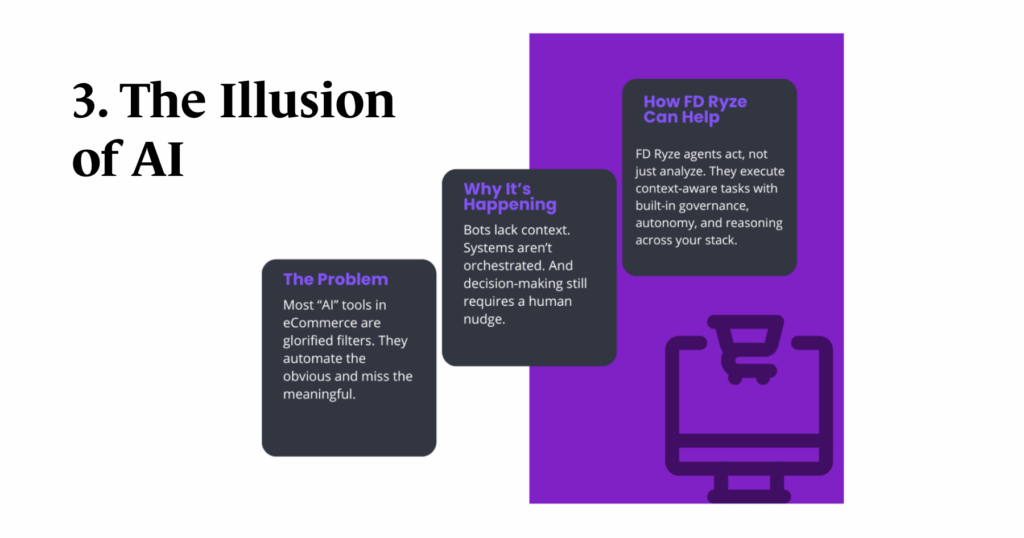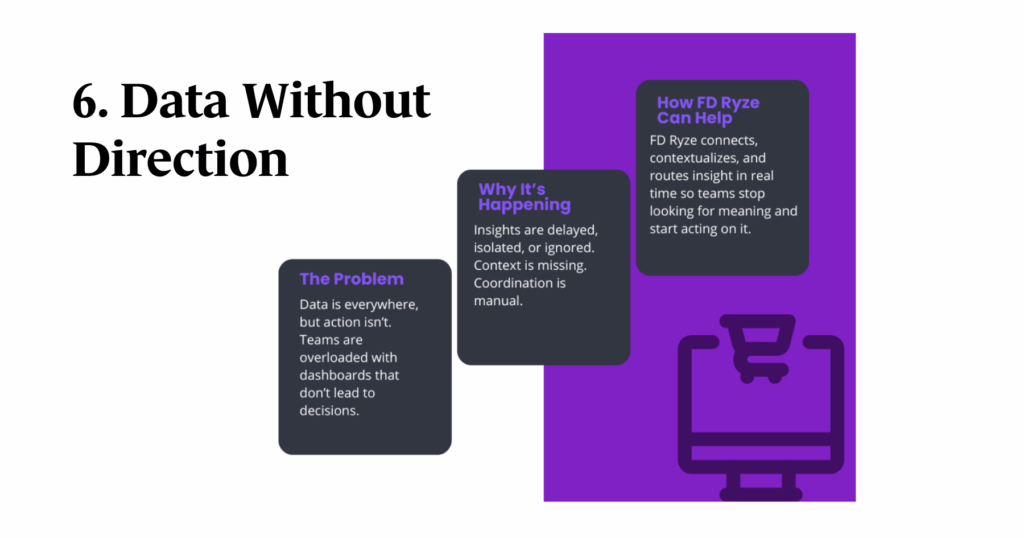Over the past few weeks, we gathered unfiltered input from founders, ops leads, and vendor-side experts across eCommerce segments, from D2C lifestyle brands and digital marketers to niche manufacturers and personalized retailers. Teams grappling with what AI actually delivers day to day and where it still falls short.
At Fulcrum Digital, we believe FD Ryze can help bridge these gaps, turning disconnected processes into orchestrated action, and static AI layers into responsive, real-time intelligence.
Here are six friction points the market called out and how agentic AI can help turn each one into a competitive advantage.
1. Post-Purchase Blind Spots
The Problem
In our conversations, several teams described a post-sale experience that is still held together by spreadsheets and ticket queues, where delays, damaged goods, or missing tracking updates quickly spiral into broken trust. Returns analysis is another blind spot. Brands can see what’s coming back, but rarely why. Few tools surface patterns, flag preventable issues, or reroute fulfillment logic in response to return behavior.
One founder described what happens after checkout as pure chaos: no intelligence, no automation, and no ownership across fulfillment, returns, or care. And that chaos isn’t just frustrating; it’s a missed opportunity to build loyalty at the exact moment when the customer is still listening.
Why It’s Happening
- Fulfillment, returns, and support often live in separate systems
- No shared AI layer to monitor sentiment, score vendors, or trigger next-best actions
- Most tools stop at shipment; they don’t own what happens next
- Post-purchase CX is treated as a cost center, not a growth lever
How FD Ryze Can Help
With agents like the Inventory Monitor, Feedback Analyzer, and Order Manager, FD Ryze helps eCommerce teams:
- Predict and preempt high-risk returns by analyzing SKU patterns, past behaviors, and product feedback in real time, well before the customer initiates a return.
- Trigger proactive interventions, from delay alerts to personalized reassurance, by detecting fulfillment risks early and coordinating across supply chain and support workflows.
- Score vendor performance dynamically based on fulfillment reliability, product condition trends, and post-sale feedback, helping reroute future orders intelligently.

2. Fragmentation Fatigue
The Problem
Everyone we spoke to had a version of the same struggle: tools that don’t talk, teams that can’t align, and insights that arrive too late or not at all. Marketing teams can’t see inventory. Ops can’t access campaign data. Supply chain leads are working off static PDFs while support agents toggle between five systems.
One ops lead told us they have the data, but it’s spread across so many tools that no one sees the full picture. Predictive analytics is grossly underused, and every team is forced to manually translate what one system knows into what another one needs. AI is present, but it’s fragmented, blind to context, and operating in silos.
Why It’s Happening
- Martech stacks, ERP systems, and fulfillment tools weren’t built to share context
- Data governance and system syncs lag behind customer-facing innovation
- AI layers often sit on top of silos instead of connecting them
How FD Ryze Can Help
FD Ryze unlocks true cross-functional intelligence with horizontally aware agents.
- Enterprise System Connector syncs insights across CRM, ERP, OMS, and PIM, closing the loop between customer, inventory, and campaign systems
- Data Insight Generator and Unstructured Data Engine process ops reports, reviews, and chat logs together, so no signal gets lost in translation
- Dynamic Agent Orchestration ensures each agent draws from the right sources, even when teams don’t (or can’t) integrate directly

3. The Illusion of AI
The Problem
While nearly every eCommerce stack includes something labeled “AI,” what’s actually under the hood often falls short of intelligence. Most tools automate simple actions or apply static rules but they don’t perceive, reason, or adapt. One product lead summed it up perfectly: “Too much dashboard, not enough do-something.”
Chatbots can’t handle nuance. Product recommendations run on recycled clickstream logic. “Omnichannel” is just a frontend promise; behind the scenes, it’s fragmented code and manual handoffs. AI is present, but it’s passive. It doesn’t make decisions. And it rarely touches the parts of the business—finance, operations, supplier risk—where it could make the most impact.
Why It’s Happening
- AI in most eCommerce tools is rule-based, not context-aware
- Generalist bots lack domain understanding, so they fail in high-touch scenarios
- “Omnichannel” is often skin-deep, with no backend orchestration or autonomy
How FD Ryze Can Help
FD Ryze brings decision-capable intelligence to the parts of eCommerce where it’s long been missing.
- Autonomous Micro-Agents don’t just surface insights, they act on them, executing tasks across sales, ops, and vendor workflows with minimal hand-holding
- Model-Agnostic Intelligence allows FD Ryze to pick the best LLM for the task, balancing cost, context, and performance in real time
- Agent Governance Layer enforces guardrails, ensuring each decision is explainable, auditable, and aligned with your policies, not someone else’s black box

4. Personalization Without Depth
The Problem
Everyone promises personalization, but most customer journeys still feel shallow. Brands talk about delivering tailored experiences, yet what customers see are recycled recommendations, one-size-fits-all offers, and site content that barely changes with context.
Multiple teams we spoke to called out the same issue: personalization engines aren’t evolving with customer behavior. A shopper’s location, urgency, past intent, or cultural nuance rarely informs what they’re shown. One marketer described it as surface-level at best and nowhere “enough to move the needle.” Even brands that position themselves as lifestyle-driven struggle to reflect deeper customer identity or intent.
Without real-time adaptation, personalization doesn’t drive relevance, it drives fatigue.
Why It’s Happening
- Most systems rely on static rules or narrow segment tags
- Behavioral signals aren’t integrated fast enough to shift content dynamically
- Nuance, like cultural context, product usage intent, or emotional tone, is ignored
How FD Ryze Can Help
FD Ryze delivers personalization that adapts to the moment, not just the persona.
- Multichannel Personalization Engine adjusts site content, offers, and recommendations in real time based on live behavior, urgency, and user context
- Customer Feedback Engine mines reviews, chats, and past queries to refine personalization based on sentiment and intent, not just click history
- Behavioral Signal Interpreter uses cross-channel cues (location, weather, time, frequency) to shape discovery and engagement at the individual level

5. Leaving the Middle Behind
The Problem
While large marketplaces and enterprise brands get purpose-built AI tools and lean startups get flexible plug-ins, mid-market and niche players are stuck in the middle. Their needs are too complex for off-the-shelf platforms, but they lack the internal teams or budgets to build AI in-house.
Founders and operations leads from personalized and made-to-order brands described a constant trade-off between scale and control. Platforms don’t support hybrid fulfillment or custom logic. Integrating storytelling, guided selling, or workflow-specific nudges? Nearly impossible without developer support. As one digital lead explained, the issue goes beyond visibility; it’s about being forced to work around tools built for business models nothing like their own.
Why It’s Happening
- Most AI tools target enterprise templates or single-product sellers
- SMBs and mid-market brands have hybrid needs but limited dev support
- Flexibility, not scale, is their differentiator, but tools rarely account for that
How FD Ryze Can Help
FD Ryze gives mid-market and niche brands an agentic workforce that flexes to their way of working.
- Low-Code Agent Deployment allows teams to spin up purpose-specific agents (e.g., restock nudges, return scoring, quote personalization) without writing code
- Modular Agent Stores let brands pick only the agents they need. No bloated platform bundles or rigid workflows
- Vertical-Aware Agents are trained for hybrid commerce use cases like made-to-order personalization, guided selling, or multi-channel fulfillment logic

6. Data Without Direction
The Problem
eCommerce brands are sitting on a goldmine of data: site behavior, campaign metrics, customer feedback, supply chain inputs. But very little of it turns into timely, coordinated action and teams still rely on manual exports and lagging reports to understand what’s happening across the funnel.
In our conversations, this disconnect came up repeatedly. Attribution models fail because analytics doesn’t align with real-time decisions. Support data insights rarely inform fulfillment logic. Return patterns don’t reach merchandising fast enough to change anything. One marketing lead told us they weren’t short on data but short on clarity: it wasn’t always clear what the data meant or who was supposed to act on it.
Why It’s Happening
- Data is captured but not interpreted or operationalized in real time
- Insights exist, but they’re delayed, underused, or siloed within teams
- Most BI tools are retrospective; too slow for fast-moving decisions
How FD Ryze Can Help
FD Ryze turns scattered signals into timely, cross-functional intelligence.
- Unstructured Data Engine processes reviews, tickets, supplier emails, and chat logs, adding qualitative context to quantitative metrics
- Live Forecasting Models generate demand, inventory, or churn predictions that flow into active workflows rather than static reports
- SLA & Compliance Dashboards push real-time insights to the right teams, reducing lag and increasing accountability

These are all solvable problems. But it can only be done with AI that understands context, moves with intent, and works across workflows.
Ready to move beyond fragmented AI? Let’s talk about how FD Ryze can help.





